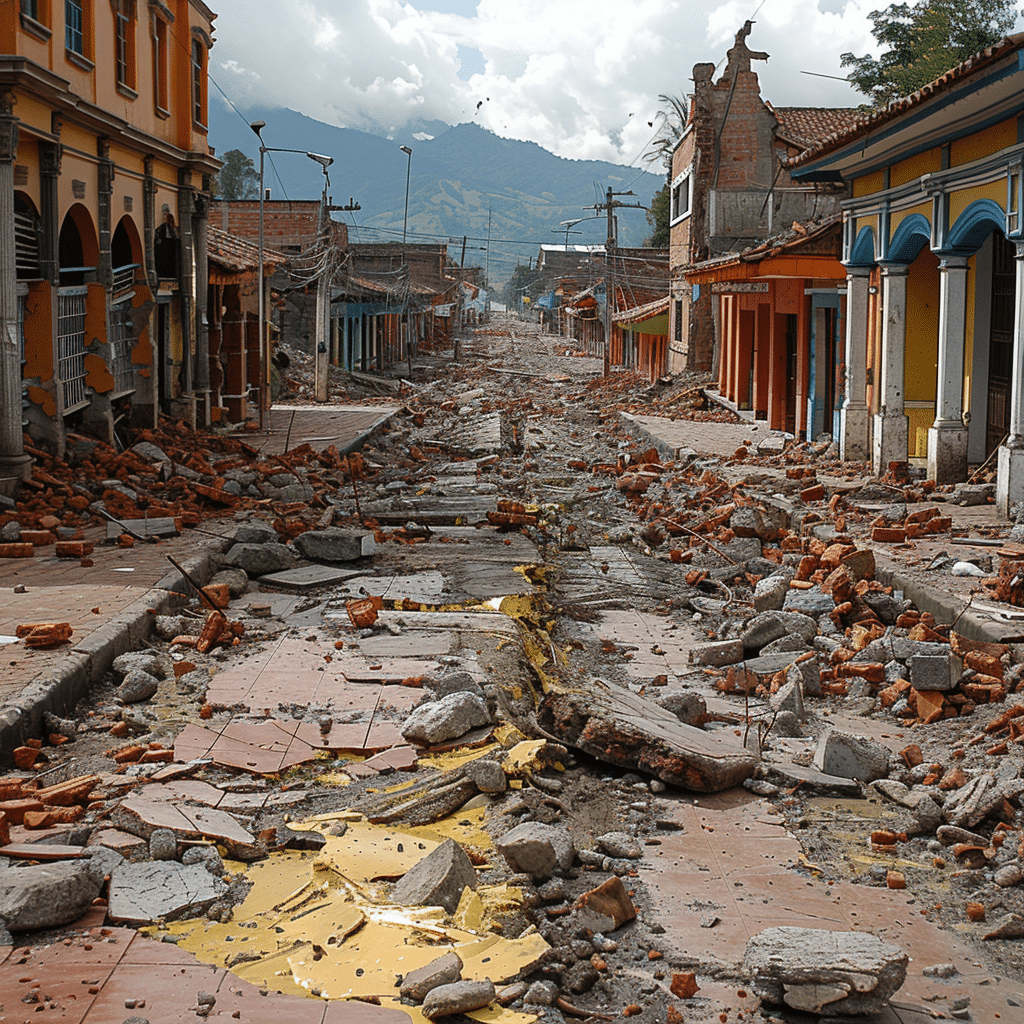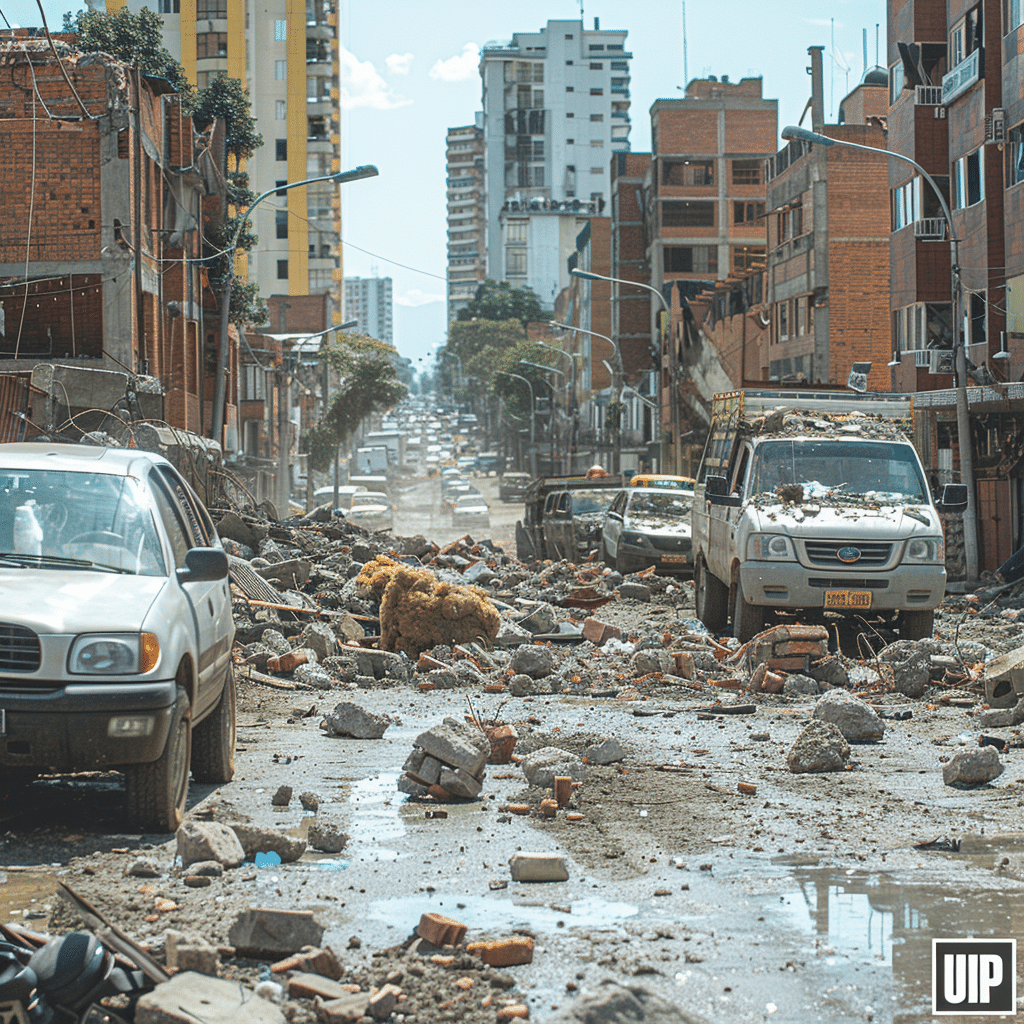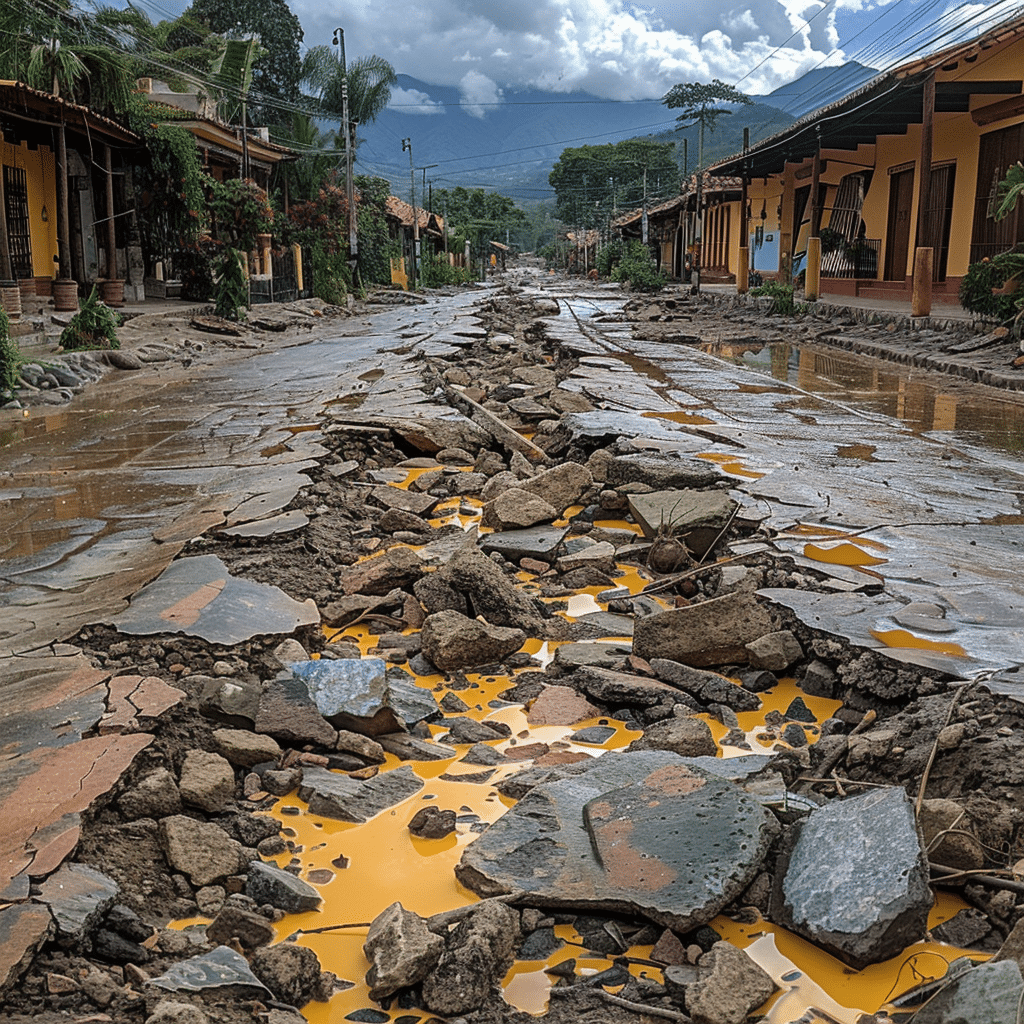Understanding Earthquake Colombia Earthquake Phenomenon
Colombia is no stranger to earthquakes. Situated on the Pacific Ring of Fire, the country deals with seismic activity almost daily. Don’t underestimate the interactions between the South American Plate, the Nazca Plate, and the Caribbean Plate—they’ve made Colombia one of the most seismically active regions globally. From minor tremors to potentially devastating quakes, Colombian landscapes endure an endless battle with the earth beneath.
The tectonic setup in Colombia is a seismic cocktail, featuring boundary clashes between the Malpelo, Panama, Caribbean, North Andes, and South American Plates. This bustling seismic scene means large parts of Colombia frequently face the threat of earthquake activity. According to the General Study of Seismic Hazards in Colombia (INGEOMINAS-AIS-1997), which categorizes the country into high, medium, and low seismic hazard zones, Bogotá stands in a medium-risk area. Despite this, many Colombians remain unaware of their seismic vulnerabilities.
Historical Context of Earthquakes in Colombia
Notable Earthquakes in Colombian History
Popayán Earthquake, 1983
Impact: The Popayán Earthquake, a moderate magnitude-5.5 tremor, wreaked havoc on the historic city. Over 250 lives were lost, and thousands more were injured, leaving scars that linger even today.
Response: This tragedy spurred major changes. The Colombian government revamped its building codes and bolstered emergency preparedness protocols, aiming to reduce future loss and damage.
Armenia Earthquake, 1999
Impact: With a magnitude of 6.2, the Armenia Earthquake hit hard, leading to over 1,000 fatalities and massive infrastructure damage in the city. It was a stark reminder of Colombia’s seismic potential.
Rebuilding Efforts: The aftermath saw immense reconstruction efforts. The government, alongside international aid organizations like the Red Cross and Médecins Sans Frontières, launched widespread rebuilding initiatives, getting communities back on their feet.

| Aspect | Details | ||
| Seismic Risk | High across many areas due to location along boundaries of Malpelo, Panama, Caribbean, North Andes, and South American Plates in the Pacific Ring of Fire. | ||
| Key Geological Plates | Malpelo, Panama, Caribbean, North Andes, South American Plates | ||
| Seismic Zones | High, Medium, Low | ||
| Seismic Zonation Reference | According to INGEOMINAS-AIS-1997 study | ||
| Seismically Active Regions | Most earthquakes occur in the North Andes Plate region | ||
| Historical Earthquakes | No recent destructive earthquakes, contributing to low seismic awareness among inhabitants | ||
| Seismic Hazard in Bogotá | Medium Risk | ||
| Seismic Hazard Distribution | • High hazard: Along the Pacific coast and areas close to plate boundaries | ||
| • Medium hazard: Including Bogotá and other central areas | |||
| • Low hazard: Eastern plains and some localized regions | |||
| Public Awareness | Generally low due to absence of major destructive earthquakes in recent history | ||
| Preparedness Measures | Needs improvement to handle potential future earthquakes | ||
| Parameter | High Hazard Areas | Medium Hazard Areas | Low Hazard Areas |
| Major Cities | Cali, Medellín, Buenaventura | Bogotá, Manizales, Bucaramanga | Villavicencio, Leticia |
| Infrastructure Risk | Potential for significant damage | Moderate risk | Low risk based on current data |
| Population Awareness | Moderate (urban regions better informed) | Low to moderate | Generally low |
| Government Preparedness | Improving, but gaps remain | Need for better risk communication | Limited measures in place |
Geographical and Geological Factors
Colombia’s geography plays a crucial role in its earthquake readiness:
The Andean Region
The Caribbean Coast
This patchwork of different geological setups means various parts of Colombia experience earthquakes differently, adding layers of complexity to preparation and resilience strategies.
Current Earthquake Preparedness and Risk Mitigation
Advances in Earthquake Early-Warning Systems
Colombia’s making big strides in earthquake readiness, and it’s about time. Here are some noteworthy initiatives as of 2024:
Sistema de Alerta Temprana de Eventos Sísmicos: This cutting-edge early-warning system, a collaboration with the Japan International Cooperation Agency (JICA), offers vital seconds of warning before a quake strikes. These moments can be the difference between life and death.
Community Education: Organizations such as the Colombian Red Cross are capitalizing on educational programs. They’re busy teaching communities how to establish emergency plans and conduct evacuation drills. Educating citizens is critical for ensuring swift and efficient responses to earthquakes.
The Implications of Urban Development on Earthquake Resilience
Urban centers in Colombia face distinct challenges when it comes to earthquake resilience:
Bogotá: With its dense population and numerous high-rises, Bogotá’s vulnerabilities are a ticking bomb. The city has adopted stringent building codes modeled after California’s seismic regulations to mitigate risks.
Medellín: Known for its forward-thinking urban design, Medellín is incorporating earthquake-resistant materials and designs in new construction projects. This proactive approach helps cushion the impact when the earth shakes.

Economic Impact of Earthquakes on Colombia
Case Studies of Economic Disruption
Cali Earthquake, 2008: Though minor at 4.7 magnitude, this earthquake caused considerable economic disruption. Damaged infrastructure led to immediate losses in commerce and had a lasting impact on local tourism.
Quindío Earthquake, 2019: This event underscored financial vulnerabilities within the agricultural sector, causing millions in damages to coffee crops and affecting Colombia’s export economy. It served as a wake-up call for the government to prioritize economic resilience.
Proactive Measures and Future Outlook
Building Retrofitting
The Colombian government has initiated programs to retroactively apply seismic standards to older structures, especially schools and hospitals. Retrofitting helps bring aging buildings up to modern safety standards.
Infrastructure Investment
Investments are pouring into resilient infrastructure. Projects include constructing flexible bridges and earthquake-proof utilities to withstand seismic shocks, offering communities a safety net in the face of future earthquakes.
A Glimpse into the Future of Earthquake Preparedness
What does the future hold for earthquake preparedness in Colombia? Here are some forward-looking ideas:
Technological Advancements: Leveraging AI and machine learning to predict seismic activity with greater accuracy could revolutionize Colombia’s earthquake preparedness. These technologies can offer unprecedented foresight.
Community Involvement: Engaging communities in earthquake preparedness programs can foster a strong culture of readiness and resilience. Grassroots participation in drills and planning can help people act swiftly when disaster strikes.
In summary, earthquakes are an unavoidable aspect of Colombia’s geographic reality. Through diligent planning and advanced technology, the nation can mitigate risks and protect its people. This collective effort is not merely a governmental duty but a shared national responsibility. With more education and proactive measures, Colombia can turn the tide against this seismic threat.
For more information on earthquake preparedness, explore relevant topics like joliet police manhunt and How many Awards Has Taylor swift won. Stay informed, stay prepared.
Earthquake Colombia: Risks Explained and Assessed
Earthquakes in Colombia are an incredibly fascinating topic. Did you know Colombia sits on the Pacific Ring of Fire, an area with high seismic activity? This geographical fact is both a blessing and a curse, giving Colombia its mountainous beauty but also making it highly prone to earthquakes. Sneakily, earthquakes here can be as unpredictable as the outcome of the man city Vs Bsc young Boys Standings.
Shocking Earthquake Facts
One intriguing aspect of Colombian earthquakes is their depth. Many quakes here are deep-focus, meaning they originate over 300 kilometers below the surface. This deep-focus nature can often lead to less immediate surface damage, but the shaking can still be intense. In comparison to shocking plot twists in a horror Manga, Colombian quakes can leave you just as surprised.
Historical Quakes
Historically, one of the deadliest earthquakes in Colombia occurred in Popayán in 1983, resulting in significant destruction and loss of lives. The quake’s aftermath was so chaotic that it seemed like something straight out of the cast Of handyman From hell. Today, Colombia continues to enact stricter building codes to mitigate future disasters.
Quakes and Culture
Interestingly, earthquakes have also influenced Colombian culture. For instance, local legends and folklore often speak of the trembling earth as a sign from the gods. Imagine discussing these myths as casually as you might talk about Djokovic Australian Open victories! Such cultural narratives add an additional layer to Colombia’s seismic reality.
Trivia Tidbits
Here’s a quirky fact: in 2008, an earthquake in central Colombia led to a stampede at a soccer match, eerily mirroring events like a Justin Bieber car accident. These incidents highlight how deeply ingrained the threat of earthquakes is in daily life, akin to how Eddie Ray rout stories permeate popular culture. And did you know even anime enthusiasts aren’t immune to seismic concerns? Colombian fans of shows like Mask Danshi wa Koishitakunai no ni anime often incorporate earthquake drills into their daily routines.
By understanding these aspects, we start to appreciate the always-interesting life amid the seismic shifts of Earthquake colombia.

When was the last time Colombia had an earthquake?
Colombia last experienced a notable earthquake on February 3, 2024, but there have been numerous minor tremors throughout the years due to its seismic activity.
Is Colombia known for earthquakes?
Colombia is definitely known for earthquakes because it’s situated at the boundaries of several tectonic plates: Malpelo, Panama, Caribbean, North Andes, and South American Plates, making it a seismically active region.
Is the Medellin earthquake prone?
Medellín, like other areas in Colombia, does experience earthquakes, though it’s not considered one of the most earthquake-prone areas in the country.
Is Bogotá at risk for earthquakes?
Bogotá is indeed at risk for earthquakes since it’s in an area classified as medium seismic risk according to the General Study of Seismic Hazards in Colombia.
How bad is a 6.3 earthquake?
A 6.3 earthquake is quite significant and can cause major damage, especially to poorly constructed buildings, though it’s not the most devastating size.
When was the biggest earthquake in South America?
The biggest earthquake in South America was the 1960 Valdivia earthquake in Chile, which measured a whopping 9.5 on the Richter scale.
What country is number 1 for earthquakes?
Japan often tops the list for the number of earthquakes, being one of the most seismically active countries in the world.
Which country has the worst earthquake?
The worst earthquake in history is usually considered to be the 1556 Shaanxi earthquake in China, which caused massive devastation and countless fatalities.
Has Colombia ever had a tsunami?
Colombia has experienced a few instances of tsunamis, but they’re relatively rare. Historical records show some have occurred.
Where is the deadliest earthquake?
The deadliest earthquake ever recorded happened in Shaanxi, China, in 1556, which resulted in approximately 830,000 deaths.
Which is the most earthquake prone city in the world?
Tokyo, Japan, is widely recognized as the most earthquake-prone city in the world due to its location near major tectonic plate boundaries.
Where is the world’s highest risk of earthquakes?
Japan, particularly the areas around Tokyo and the Pacific coast, holds the highest risk of earthquakes globally owing to its tectonic setting.
What US city is known as earthquake capital of the world?
Parkfield, California, is often referred to as the earthquake capital of the world because it sits on the San Andreas Fault and experiences frequent tremors.
Is it safe to walk in Bogota?
Walking in Bogotá is generally safe, especially in main areas during the day. However, as with any large city, it’s best to stay vigilant and avoid lesser-known areas at night.
Is it safe to travel to Bogota right now?
Travel to Bogotá is safe right now, but it’s wise to stay updated on local news and follow any travel advisories from your home country.
How many people died in the Colombia earthquake 1999?
The 1999 Armenia earthquake in Colombia resulted in around 1,185 deaths, mostly due to building collapses and landslides.
When was the last tsunami in Colombia?
The last notable tsunami in Colombia was relatively small and occurred following a marine earthquake, but specific details about the most recent one can vary.
How many people died in the 1906 Ecuador Colombia earthquake?
The 1906 Ecuador-Colombia earthquake led to around 1,500 deaths, primarily due to the severe impact and subsequent tsunami.
What kind of natural disasters happen in Colombia?
Colombia faces various natural disasters, including earthquakes, volcanic eruptions, landslides, and occasionally tsunamis. The diverse geography contributes to these events.



